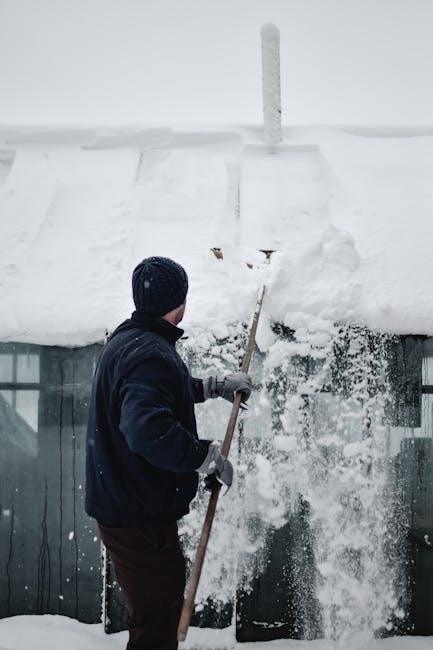Welcome to the MTD Snow Blower User Manual. This guide provides essential information for safe and effective operation, including assembly, maintenance, and troubleshooting tips. Ensure optimal performance and longevity by following the instructions carefully.
1.1 Overview of the MTD Snow Blower
The MTD Snow Blower is a reliable and efficient tool designed to handle various snow-clearing tasks. Available in multiple models, including the 600 SERIES, 642E, and 642F, these units offer robust performance for residential and light commercial use. Features include powerful engines, adjustable chute controls, and durable construction. The snow blowers are designed to tackle different snow conditions, from light powder to heavy, wet snow. With options for single-stage and two-stage models, users can choose the right machine for their specific needs. The equipment is accompanied by detailed user manuals that guide owners through operation, maintenance, and troubleshooting. Whether you’re clearing a small driveway or a large area, the MTD Snow Blower provides a practical solution for winter snow removal.
1.2 Importance of the User Manual
The user manual is a crucial resource for MTD Snow Blower owners, ensuring safe and effective operation. It provides detailed instructions for assembly, maintenance, and troubleshooting, helping users maximize performance and longevity. The manual covers essential safety precautions, such as avoiding unimproved forest-covered areas and understanding engine exhaust guidelines. It also outlines features specific to each model, like the auger/impeller control lever, and offers setup adjustments for optimal use. By following the manual, users can prevent accidents and maintain their equipment properly. Regular maintenance schedules and seasonal storage tips are included to keep the snow blower in excellent condition. Whether addressing common issues or guiding DIY repairs, the manual serves as an indispensable guide for all MTD Snow Blower operators.

Safety Precautions
Always follow safety guidelines to avoid accidents. Keep hands away from rotating blades and inlet openings. Avoid operating near flammable materials or unimproved forest areas. Never modify the machine.
2.1 General Safety Warnings
Always read and follow all safety guidelines before operating the MTD Snow Blower. Keep hands and feet away from rotating blades and inlet openings, as they can cause severe injury. Never operate the machine near open flames, sparks, or flammable materials. Avoid using the snow blower on steep slopes or unstable surfaces. Ensure the area is clear of debris, children, and pets. Wear protective gear, including gloves and safety glasses, to minimize risks. Never modify the machine or bypass safety features, as this can lead to accidents. Be aware of your surroundings and maintain a safe distance from bystanders. Follow all warnings and instructions provided in the manual to ensure safe and effective operation. Regularly inspect the machine for damage or wear and address issues promptly. Proper use and adherence to safety guidelines are essential for preventing injuries and ensuring optimal performance.
2.2 Protective Gear and Apparel
Wearing proper protective gear is essential for safe operation of the MTD Snow Blower. Always wear durable gloves to prevent blisters and improve grip. Safety glasses or goggles are crucial to protect your eyes from flying debris. Choose sturdy, waterproof boots with good traction to prevent slipping on icy surfaces. Dress in layers with warm, breathable clothing to stay comfortable in cold conditions; A scarf or neck gaiter can shield your face from wind and snow. Wear a hat to retain body heat, and consider using reflective gear for visibility in low-light conditions. Avoid loose clothing that could get caught in moving parts. Ensuring you are properly equipped reduces the risk of injury and enhances your overall safety while operating the snow blower.
2.3 Safety Features of the MTD Snow Blower
The MTD Snow Blower is equipped with several safety features to ensure safe operation and minimize risks. The auger/impeller control lever acts as a safety device, preventing accidental start-up and ensuring the machine stops when released. An emergency stop switch is conveniently located for quick shutdown in case of an emergency. The machine also features protective shields to guard against flying debris and snow. Additionally, the engine is designed with an overhead valve for efficient operation and reduced emissions. The snow blower is constructed with durable materials to withstand harsh winter conditions. Always ensure these safety features are functioning properly before use. Regular maintenance and adherence to safety guidelines will further enhance the overall safety of the MTD Snow Blower, making it a reliable tool for clearing snow effectively.

Assembly Instructions
Begin by carefully unpacking and inventorying all components. Follow the step-by-step guide to assemble the snow blower, ensuring all parts are securely attached. Proper assembly is crucial for safe operation.
3.1 Unpacking and Inventory
Begin by carefully unpacking the MTD snow blower from its box. Ensure all components are accounted for by cross-referencing the packing list with the items in the box. This step is crucial to confirm that no parts are missing or damaged during shipping. Inspect the unit for any visible damage and verify that all hardware, such as bolts, screws, and attachments, are included. Pay special attention to essential parts like the auger, chute, and control cables. Organize smaller components, such as the hardware bag, in a safe place to avoid misplacement. If any items are missing or damaged, contact the manufacturer immediately. Proper inventory ensures a smooth assembly process and prevents delays. Always refer to the manual for a detailed list of included parts and tools required for assembly.
3.2 Step-by-Step Assembly Guide
Begin by gathering all necessary tools and components listed in the manual. Start with attaching the handlebar by aligning the mounting brackets and securing them with the provided bolts. Tighten firmly but avoid over-tightening. Next, install the chute and deflector by inserting the chute into the discharge outlet and securing it with the included hardware. Ensure proper alignment for smooth snow discharge. Attach the auger housing to the main unit, making sure all screws are tightened evenly. Refer to the manual for specific torque values. Adjust the skid shoes to the desired height to protect surfaces from damage. Finally, connect the control cables to the auger and chute, ensuring they move freely. Double-check all connections and test the controls before first use. If unsure, consult the manual or contact support.
3.3 Initial Setup and Adjustments
After assembly, perform initial setup and adjustments to ensure proper functionality. Check and adjust the skid shoes to the desired height to prevent surface damage. Align the chute and deflector to direct snow flow accurately. Tighten all bolts and screws to the specified torque values in the manual. Adjust the control cables for smooth operation of the auger and chute. Ensure the belt is properly tensioned for optimal performance. Lubricate all moving parts as recommended. Test the machine on a flat surface to verify proper function. Make any necessary adjustments to the handlebar or chute alignment for comfortable operation. Refer to the manual for specific adjustment procedures and torque specifications. Proper setup ensures efficient snow clearing and extends the lifespan of your MTD Snow Blower.
Operating Instructions
Familiarize yourself with the controls and start the engine as outlined. Adjust the chute and deflector for optimal snow flow. Operate on level surfaces, adjusting settings for varying snow conditions.
4.1 Starting the Engine
To start your MTD snow blower’s engine, first ensure the fuel level is adequate. If it’s a gas model, check the fuel gauge or tank. Next, prime the engine by squeezing the primer bulb 2-3 times to draw fuel into the carburetor. Set the choke to the “start” or closed position to enrich the fuel mixture for a cold start. Ensure the auger and drive systems are disengaged for safety. Locate the ignition, which may be a recoil starter (pull cord) or an electric start. For a recoil starter, grip the handle firmly and pull the cord sharply until the engine ignites. Once running, gradually open the choke to the “run” position to stabilize the idle. If your model has an electric start, turn the key or press the ignition button. Always refer to your specific user manual for precise instructions, as procedures may vary slightly between models. Proper starting techniques ensure reliable performance and prevent engine issues. Additionally, consider the throttle position, often set to a medium or high setting during startup. If the engine doesn’t start after several attempts, inspect the spark plug and air filter for potential issues. For new machines, observe any recommended break-in procedures to avoid overloading the engine initially. Starting the engine correctly is crucial for both performance and longevity of your MTD snow blower.
4.2 Using the Controls and Features
Familiarize yourself with the controls to operate your MTD snow blower effectively. The auger/impeller control lever engages the spinning auger and impeller, which drive the snow through the chute. Always ensure this lever is in the “off” position before starting the engine. The throttle control adjusts engine speed, allowing you to match power to snow conditions. For precise snow placement, use the chute control to direct the snow stream left or right and the deflector to adjust the height. Some models feature power steering and drift cutters for enhanced maneuverability and deep snow handling. Ensure all controls are easily accessible and functioning properly before operation. Proper use of these features ensures efficient snow clearing and machine longevity.
4.3 Operating Tips for Different Snow Conditions
Adjust your technique based on snow conditions for optimal performance. For light snow, maintain a steady pace and keep the chute angle low to prevent blowing snow too far. In deep snow, reduce your forward speed and make multiple passes to avoid overloading the blower. When handling icy or packed snow, use the drift cutter (if equipped) to break through dense areas and apply gentle, consistent pressure. For slushy or wet snow, slow down and avoid overfilling the auger to prevent clogs. In extreme cold, ensure all moving parts are well-lubricated and check for ice buildup in the chute. Always stay alert and adapt your strategy to the specific conditions for safe and efficient snow removal.
Maintenance Tips
Regular maintenance ensures your MTD snow blower performs optimally. Lubricate moving parts, check belts, and inspect the auger for damage. Store properly after each use and seasonally to prevent rust and wear. Always refer to the manual for specific maintenance schedules and procedures to extend the life of your equipment.
5.1 Regular Maintenance Schedule
To ensure your MTD snow blower operates efficiently, follow a regular maintenance schedule. Daily checks include inspecting the auger and impeller for debris, lubricating pivot points, and ensuring all bolts are tightened. Weekly, clean the machine thoroughly, paying attention to the chute and discharge area, and drain old fuel if the blower will not be used for an extended period. Seasonally, sharpen the auger, change the engine oil, and inspect the spark plug; Always refer to the manual for specific recommendations tailored to your model. Proper maintenance prevents wear, ensures safety, and prolongs the life of your snow blower. Regular upkeep also helps avoid costly repairs and ensures reliable performance during harsh winter conditions.

5.2 Seasonal Preparation and Storage
Proper seasonal preparation and storage are crucial for maintaining your MTD snow blower’s performance and longevity. At the end of the winter season, drain the fuel tank or add a fuel stabilizer to prevent degradation. Clean the machine thoroughly, removing dirt, snow, and debris from the auger, chute, and other components. Apply rust-inhibiting oil to metal parts to protect against corrosion. Check for loose or damaged parts and secure or replace them as needed. Store the snow blower in a dry, well-ventilated area away from direct sunlight and moisture. Avoid storing it near open flames or sparks, as residual fuel vapors could ignite. Proper storage ensures the blower remains in good condition for the next winter season and minimizes the risk of damage or mechanical issues.
5.3 Winter Storage and Spring Startup
Proper winter storage and spring startup are essential for maintaining your MTD snow blower’s efficiency and longevity. During winter, ensure the blower is stored in a dry, protected area to prevent moisture damage. Cover the machine to shield it from dust and debris. In the spring, inspect the snow blower for any damage or wear, such as cracked belts or corroded parts. Reassemble any components disassembled for storage and check the tire pressure. Test the engine by adding fresh fuel and ensuring all controls function correctly. Lubricate moving parts and replace worn accessories as needed. Finally, clear the chute and auger of any debris to ensure smooth operation when winter returns. Proper preparation now will ensure your MTD snow blower performs reliably next season.

Troubleshooting
Identify common issues like auger not turning or engine stalling. Check for clogged chutes, worn belts, or low fuel. Refer to the manual for detailed solutions or contact a professional if problems persist.
6.1 Common Issues and Solutions
Troubleshooting your MTD snow blower? Common issues include the auger not turning, engine stalling, or chute clogging. For an auger malfunction, check the belt for wear or damage and ensure the auger control is engaged. If the engine stalls, verify fuel levels, air filter cleanliness, and spark plug condition. Clogged chutes often result from wet snow buildup; clear blockages manually. If the machine vibrates excessively, inspect for unbalanced or damaged blades. For persistent issues, consult the manual or contact a certified technician. Regular maintenance, such as lubricating moving parts and replacing worn components, can prevent many problems. Always follow safety guidelines when performing repairs to avoid injury or further damage.
6.2 DIY Repair and Service
Performing DIY repairs on your MTD snow blower can save time and money. Start by identifying the issue using the troubleshooting guide. Common DIY fixes include replacing worn belts, cleaning or replacing spark plugs, and clearing clogged chutes. Always disconnect the spark plug wire before starting repairs to ensure safety. For belt replacements, refer to the manual for correct part numbers and installation steps. If the auger or impeller is damaged, inspect for loose bolts or debris and tighten or remove obstructions as needed. Lubricate pivot points and cables regularly to maintain smooth operation. For more complex issues, consult the manual for torque specifications and diagrams; Remember to wear protective gear and follow safety guidelines during any repair to avoid injury or further damage to the machine.
6.3 When to Contact a Professional
If you encounter complex issues beyond basic DIY repairs, such as major engine damage, electrical system malfunctions, or significant auger/impeller wear, it’s best to contact a professional. Professionals have the expertise and tools to address these problems safely and effectively. Additionally, if you’re unsure about diagnosing or fixing an issue, consulting a certified technician can prevent further damage or safety hazards. For warranty-related repairs, always contact an authorized MTD service center to ensure coverage. Difficult repairs, such as hydrostatic transmission issues or intricate mechanical overhauls, should also be handled by professionals. Remember, safety and machine longevity are priorities, so don’t hesitate to seek expert assistance when needed.

Accessories and Attachments
Explore a variety of MTD Snow Blower accessories, such as drift cutters, remote chute controllers, and attachment kits, to enhance performance and versatility for different snow-clearing tasks.
7.1 Available Accessories
The MTD Snow Blower offers a range of accessories to enhance its functionality. These include drift cutters, which improve performance in deep snow, and remote chute controllers, allowing easy adjustment of snow discharge direction. Additional attachments like snow blower lights provide better visibility in low-light conditions, while weighted wheels increase traction on icy surfaces. Other options include skid shoes to protect surfaces and extension kits for increased throwing distance. These accessories are designed to customize the snow blower to specific needs, ensuring efficient and safe operation in various snow conditions. Always refer to the compatibility list to ensure the accessory works with your model. Proper installation and use of these accessories can significantly improve your snow-clearing experience.
7.2 Installing and Using Attachments
Proper installation and use of attachments are crucial for optimal performance. Always follow the manufacturer’s instructions for each accessory. Begin by ensuring the snow blower is turned off and the key is removed before installing any attachment. For drift cutters, align them with the auger housing and secure tightly. Remote chute controllers require connecting the cables to the chute assembly, ensuring smooth operation. Test the attachment after installation to confirm proper function. Refer to the user manual for specific torque values and mounting locations. Regularly inspect attachments for wear and tear. If unsure about installation, consult a professional to avoid damage or safety hazards. Properly installed attachments enhance efficiency and safety, ensuring your MTD Snow Blower operates at its best in all conditions.
This manual provides comprehensive guidance for safe and effective use of your MTD Snow Blower. Always follow safety precautions, maintain the unit regularly, and use attachments correctly for optimal performance and longevity.
8.1 Summary of Key Points
This manual has provided detailed guidance on safely operating and maintaining your MTD Snow Blower. Key points include adhering to safety precautions, proper assembly, regular maintenance, and effective operation techniques. Always read the manual before use to understand safety rules and operational guidelines. Proper assembly ensures functionality, while regular maintenance extends the life of your snow blower. Troubleshooting common issues and knowing when to contact a professional are essential for resolving problems efficiently. Additionally, using recommended accessories and attachments enhances performance. By following the instructions and tips outlined in this manual, you can ensure optimal results and prolong the lifespan of your equipment. Remember to consult the manual for specific model details and always follow manufacturer recommendations for safe and effective use.
8.2 Final Tips for Effective Use
To maximize the performance of your MTD Snow Blower, always store it properly after use, ensuring the fuel tank is empty and the machine is clean. Regularly check and replace worn parts to maintain efficiency. For optimal results, use the correct snow blower model for your snow conditions and surface type. Avoid overloading the machine, as this can reduce performance and damage the engine. Keep the area clear of debris before operation to prevent clogs. If you notice any unusual noise or vibration, stop the engine immediately and inspect for issues. Finally, always refer to the manual for specific guidance tailored to your model. By following these tips, you can ensure your MTD Snow Blower operates effectively and lasts for many winters to come.

Bonus Tips
For enhanced performance, refer to your MTD Snow Blower manual for model-specific optimizations. Adjust skid shoes for better traction and use the correct fuel type for your engine. Regularly check belts for wear and ensure all moving parts are well-lubricated before use. These simple steps can significantly improve efficiency and prolong the life of your snow blower.
9.1 Optimizing Performance
To optimize your MTD Snow Blower’s performance, regular maintenance is crucial. Check and replace worn belts, as they can degrade efficiency. Ensure the auger and impeller are free from debris, and lubricate moving parts to reduce friction. Adjust skid shoes to suit your surface type, whether it’s concrete, gravel, or pavement, to prevent damage and improve snow intake. Use the correct fuel type recommended in your manual to maintain engine health. Clear the area of obstacles before operation to avoid clogs. For enhanced throwing distance, ensure the chute and deflector are clean and properly aligned. These steps will maximize your snow blower’s efficiency and ensure reliable operation during harsh winter conditions.
9.2 Environmental Considerations
Operating your MTD Snow Blower responsibly helps minimize its environmental impact. Always use the recommended fuel type to reduce emissions and prevent spills. Regularly inspect for leaks and ensure proper disposal of waste materials. Store the unit in a dry, secure location during off-seasons to prevent contamination of soil or water. Avoid over-revving the engine, as this increases fuel consumption and emissions. Properly maintain the machine to ensure efficient operation, reducing unnecessary energy use. By following these guidelines, you can help protect the environment while keeping your snow blower in optimal condition for years to come.